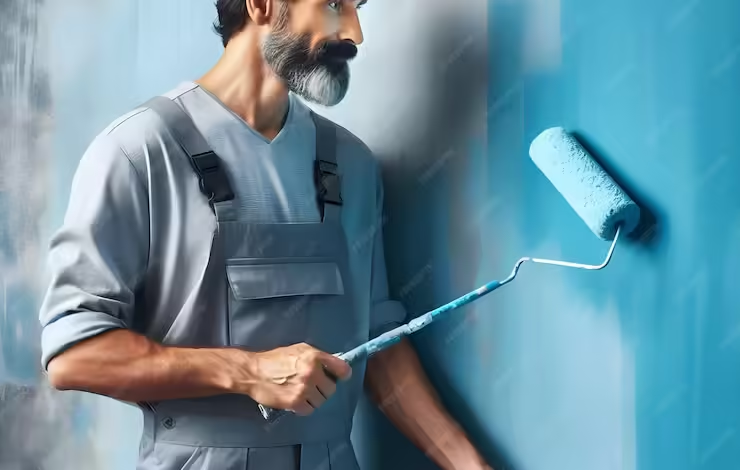Best Practices for Exterior Painting: A Quick Guide

One of the best ways to update the appearance of your house or business is through exterior painting. A new layer of paint can increase kerb appeal, shield the structure from inclement weather, and possibly increase the building’s worth. But painting the outside involves more than just choosing a colour and applying it. To guarantee long-lasting and durable effects, the necessary materials, technique, and preparation are required.
We’ll cover everything you need to know about exterior painting in this extensive guide, from selecting the best paint to following best practices to ensure a perfect finish.
1. The Significance of Exterior Painting
A vital layer of protection for your house or place of business, exterior painting is not only about aesthetics. The outside of buildings can sustain considerable deterioration over time due to elements like rain, snow, and UV radiation from the sun. An excellent paint job serves as a barrier to stop moisture from penetrating the walls, which can cause structural damage, mould, and mildew.
Outside painting not only provides protection but also raises the overall value of your home. A new coat of paint immediately improves kerb appeal, drawing potential tenants or buyers to your house. Enhancements to the outside of your house can make it stand out in competitive real estate markets, resulting in faster sales and greater offers.
2. Picking the Appropriate Paint
Particularly when it comes to external applications, not all paints are made equal. The paint you select should be long-lasting, weather-resistant, and made especially for outdoor use. When choosing paint, keep the following things in mind:
Weather Resistance: Paint for the outside should be able to endure a variety of weather, from sweltering heat to subfreezing temps. Seek for paint compositions that are moisture-resistant to prevent water damage, and look for paints that are UV resistant to prevent fading from sun exposure.
Paint Type: Latex, which is water-based, and alkyd, which is oil-based, are the two primary varieties of exterior paint. Because of their flexibility and resilience to cracking, water-based paints are widely used. They require less cleaning effort, dry faster, and contain less volatile organic compounds. Although oil-based paints take longer to cure and release more fumes, they are smoother and more durable.
Finish: There are four types of exterior paint finishes: gloss, satin, matte, and semi-gloss. Because of their resilience to dirt and grime, satin and semi-gloss finishes are frequently used for external surfaces. Windows, doors, and trim are commonly finished with gloss to give them a polished appearance.
3. Painting Your Exterior After Preparation
A great exterior paint job requires preparation. Ignoring this step might lead to an early fading, peeling, or cracking of the finish. Here are some tips for correctly priming your external surfaces before painting:
Cleaning: Paint may not adhere to surfaces correctly due to dirt, grime, and mildew. A wonderful approach to ensure a clean surface for painting is to pressure wash the external surfaces to eliminate buildup. To prevent harming the siding, use caution when adjusting the pressure.
Fixing: Look for any holes, cracks, or damaged siding that requires fixing. In order to get a smooth and even finish, these should be repaired before painting. This may occasionally entail repairing any rotting wood or damaged sections.
Sanding and scraping: Prior to painting over old paint, it’s critical to remove any peeling or flaking paint. Sanding and scraping the surface promotes a more uniform look and improves the adhesion of the fresh paint.
Painting over a darker colour or a previously unpainted surface requires the use of primer, which is crucial for external surfaces. It improves adhesion and lengthens the paint’s shelf life. There are paint and primer mixes available that reduce application time in certain situations.
4. Painting the Exterior
It’s time to paint the surfaces after they have been prepared. The project’s size, the surface’s nature, and the tools you have will determine the application technique. The most popular ways to apply are as follows:
Brushing and Rolling: Brushing and rolling are traditional methods that allow for greater precision, especially on detailed areas like trim, windows, and corners. While this method may take longer, it often results in a more even coat with fewer chances for overspray.
Spraying: For swiftly painting large surfaces like siding or fences, paint sprayers are perfect. While masking off windows, doors, and other locations where you don’t want paint to land is part of the preparation needed for this faster approach.
Multiple Coats: Applying multiple coats ensures better coverage and durability. The first coat often acts as a base layer, while the second coat adds the final, even finish. Make sure to allow enough drying time between coats as specified by the paint manufacturer.
5. Ideal Weather for Painting
The weather has a significant impact on exterior painting. Dry, somewhat warm, and low humidity conditions are ideal for painting. Most varieties of outdoor paint are typically best applied at temperatures between 50°F and 85°F.
Painting should be avoided on very hot days since the paint may dry too rapidly and cause cracking or an uneven finish. Likewise, painting in damp or muggy weather might cause bubbles or peeling when the paint doesn’t dry properly.
It’s crucial to monitor the weather prediction as well. After painting, you’ll need a few days in a row of dry weather to make sure the paint cures completely.
6. Keeping Up Your Outside Paint Job
For many years to come, even the best paint jobs need to be maintained. The following advice will help you maintain the highest quality of external paint:
Regular Cleaning: Dirt, mold, and mildew can accumulate on exterior surfaces over time. Regularly cleaning the exterior with a garden hose or pressure washer helps keep the paint looking fresh and prevents damage.
Touch-ups: You can prolong the life of your paint job and stop worse problems from arising by applying touch-up paint as soon as you discover minor areas of chipping or fading.
Examine Every Year: Every year, examine your outside paint for indications of fading, peeling, or cracking. This enables you to identify possible issues early and take action to prevent them from requiring expensive repairs.
In conclusion
Careful planning, material selection, and application best practices are all necessary for an exterior painting project to be successful. Investing in professional painting services may assure long-lasting, beautiful results, whether your goal is to preserve your home from the weather or to improve its appeal.
Get in touch with Sonshine Girls Painting, your go-to source for professionalism and high-quality exterior painting services.


